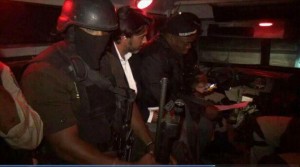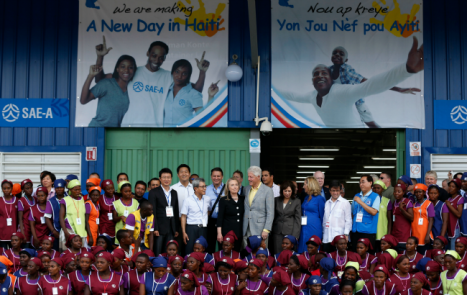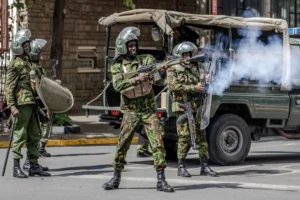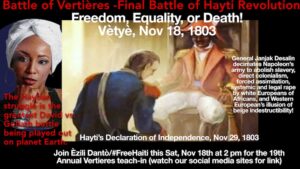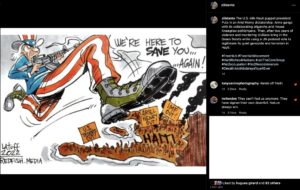Clifford Brandt Kidnapping Ring Busted as Clintons with Hollywood Celebrate Haiti Sweatshop
Update: December 9, 2012
Moscoso cousin shot dead
Jules Edouard Moscoso (57), a cousin of the two kidnapped victims of the network of Clifford Brandt was shot dead early Sunday morning December 9, 2012 in his home, 40 meters from a United Nations peacekeeping base in Léogane. Jules Edouard Moscoso, owned Dolphin, a private water company and is the cousin of Sogebank CEO, Robert Moscoso, whose two children, Nicolas and Coralie, were freed by Haiti police on October 22, 2012 after being kidnapped for a ransom of $2.5 million. It is largely suspected that this killing is not unrelated and that it’s the corrupt US cold war kleptocracy – Haitian elite mafia families – settling scores within their brutal ranks.
*******************
Clifford Brandt Kidnapping Ring Busted as Clintons with Hollywood Celebrate Haiti Sweatshop
Oct 23, 2012 (See also, Miami Herald main culprit that criminalized the poor in Haiti as kidnappers.)
On Monday, October 22, 2012, Hollywood helped the Clintons inaugurate the US’s flagship sweatshop at Caracol, Haiti. Outside, protesting Haitians who don’t applaud are arrested and silenced.
This is the best of times for unfettered capitalism and privatization reigning supreme in Haiti above all else. There’s sweatshop industrial openings with
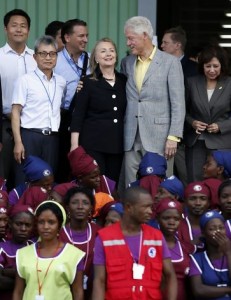
Obama Sec. of State, Hillary Clinton and former President Clinton, celebrate sweatshop opening at Caracol, Haiti. At the bottom in their own country, sad, exploited but dressed-up Haitians frame the Avatar Crew’s feet. October 22, 2012. Photo credit: Larry Downing, AP
Hollywood good-times rolling, romantic moments for Billy and Hillary while billions in misery donation dollars are used to give the South Koreans a free factory, housing and to build cruise ship berths and hotel suites that service the privileged few. Over 400,000 quake victims remain homeless. And, in just two years, UN-imported cholera has killed over 8,000 Haitians and infected over 600,000. But it’s against the US “HOPE”Act law and International financial institutions (IFIs) dictates (that allow for subsidies and bailouts to the Korean and other businesses at this industrial park) for the Haitian government to put public funds into servicing its own people’s public needs. “Leave it to the free market and the NGO business, opine the US rulers in Haiti.”
On Monday, October 22, 2012, another dirty business enterprise was being exposed while the Clintons and their wealthy Hollywood celebrityfriends were showcasing the Caracol hoax, sharing a romantic moment -“opening Haiti,” yet again, with the sharp media propaganda tools of providing relevant “jobs and housing” for Haiti.
Clifford Brandt, son of the wealthy Fritz Brandt and a member of one of Haiti’s billionaire families, was arrested at his place of business and put in handcuffs, accused of being the mastermind behind an organized kidnapping ring in Haiti.
According to Haiti officials, Clifford Brandt admitted his involvement in several kidnappings including the October 16, 2012 kidnapping on Bourdon Road of Coralie (23) and Nicolas Moscoso (24), two members of another wealthy Haiti family. On Tuesday, Oct. 23, 2012 at 3:am, the morning after his arrest, interrogation and confession, Brandt took police to the place where the two young Moscoso adults were being held. Police freed them.
Clifford Brandt is the managing director of Mazda dealership in Delmas Haiti.
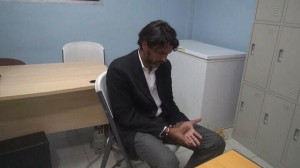 “His activity, indicated the Secretary of State for Public Security, Reginald Delva, “was to come to Haiti from his home in Miami, collect the ransom monies from his kidnapping enterprise in Haiti “
“His activity, indicated the Secretary of State for Public Security, Reginald Delva, “was to come to Haiti from his home in Miami, collect the ransom monies from his kidnapping enterprise in Haiti “
Local Haitians call this foreign-authored organized criminal activity: Ayisyen kidnape, Blan fè pri.
In a Haiti radio public broadcast, Haiti State Secretary of Public Security, Reginald Delva, interviewed by Gary Pierre Paul for Scoop FM maintains that documents show the kidnapping network Clifford Brandt is involved with demanded U.S. $2.5 million for the release of the two Moscoso victims. This is an on-going investigation explains Mr. Delva. He says authorities found a list of folks Clifford Brandt’s kidnapping ring had “a macabre plan” to kill or kidnap for the coming Christmas season.
Oct. 23 2012 Scoop FM interview
of Reginald Delva, State Secretary of Public Security by Gary Pierre Paul
Sources confirm that this well-connected mafia ring has been in operation for some time wreaking havoc in Haiti.
Many Haiti observers question whether the weak Haiti justice system will be bought out by the Brandt family, as its one of the most prominent families in Haiti where justice is oftentimes for sale. The Brandts’ friends include some of Haiti’s most powerful neocolonial corporate enemies whose many transnational businesses they give a Haiti subcontractor face to and mostly export all accumulated capital out, impoverishing Haiti, paying little to no taxes or tariffs. (See Haiti: The soul of Africa, not for sale; 05% of Haitians own 98% of Haiti’s wealth – Disaster capitalism; Shock-Doctrine Schooling in Haiti: Neoliberalism Off the Richter Scale; 206 years since Desalin.)
Clifford Brandt in handcuffs bring police to location of kidnapped victims, Coralie (23) and Nicolas Moscoso (24), who are rescued by Haiti anti-kidnapping police unit***We are not the kidnappers: Site Solèy Speaks, 2006 (HLLN archives)
|
The Untouchables: It will surprise no one in Haiti if this case is suddenly reduced to a rumor despite the photos of Mr. Brandt in handcuffs at the police station and HaitiState Secretary of Public Security, Reginald Delva public statements. Most likely, if the local Haiti authorities who broke this case are not serving a neo-colonial purpose, the ruling imperial hands may have them silenced, marginalized, fired or worse. Those who serve foreign interests, or are well connected enough to these authorities to buy their freedom, do not, like the criminalized Haiti poor, remain in prison.
In 2005, another wealthy Haitian businessman in Haiti was arrested in relation to a slew of kidnappings and crimes.
“According to police sources, the investigation in the disappearance of UNIBANK’s employee allowed police to uncover the existence of a huge and powerful network of crooks, linked with drug money laundering, kidnappings, and many other shady activities. The businessman Stanley Handal and the bank employee Genelus were apparently part of this network.” (An Important Businessman was Arrested in Relation to Kidnapping cases reported in Port-au-Prince.)
Besides the Stanley Handal example (whose case was dismissed), others connected to power and empire who still roam free, with complete impunity in US/UN occupied Haiti include: Accused kidnapper “Jerry Narcius” suspected to work for the UN; DEA-suspected drug trafficker Guy Philippe; the 2004 coup d’etat/US regime change paramilitary enforcers known as the Lame Timanchèt death squad assassins; kidnapper arrested linked to wealthy families working with Lame Timanchèt ; Michael Lucius, a top Haitian police officer indicted for kidnapping; the 15 police officers who were to face the bar of justice for brutal murders ; Louis Jodel Chamblain; and Emmanuel “Toto” Constant, the FRAPH head of the 1991 coup detat/US regime change paramilitary enforcers charge with thousands of murders, rapes and crimes against humanity. Toto Constant was granted a US visa and residency until finally caught and put in prison on mere bank fraud charges there.
For decades, Haiti’s worst violence has been authored, not locally, but mostly imported. (Our nasty little racist war in Haiti; Eyewitness account of the abduction of President and First Lady Aristide of Haiti by the United States Special Forces; Obama’s offered HOPE is sweatshop slavery.)
Kidnapping in Haiti began to find a footing after the UN took over and with the 2004 US kidnapping of president Aristide out of Haiti back to Africa. The powerful, connected and wealthy are the worst purveyors of violence and corruption in Haiti. (Yo se chèf zinglendo yo, epi yo di se Nèg nan Geto, se ti malere k’ap bay pwoblèm: Corruption uninterrupted in Haiti)
The international and national media which are owned by the corporate organizations mostly benefiting from the status quo, will generally criminalized the poor, disenfranchised and working masses worldwide. This is why Ezili’s HLLN continually ask this most pertinent question:
Why is there a UN, Chapter 7 peace enforcement mission in Haiti for 8 years? A country not at war, without a peace agreement to enforce and with less violence than most countries in the Western Hemisphere?” (See the UN’s own Global Study on Homicide at page 93 and Legacy of Impunity.)
The wealthy sons of Haiti’s Oligarchy, who’ve formed organized killing coup d’etat and criminal gangs known to local Haitians as, the Ninjas, have eluded the law and prison time. With their connections to power and the police, rarely have suspected members of the Ninjas spent time in prison and then not for long. Crime in Haiti is generally blamed on the poor in Site Solèy. (See transcripts at HLLN archives at “We are not Kidnappers” and Original Kreyòl Audio of Interview:We are not Kidnappers – Site Solèy speaks, May 22, 2006, Ezili Dantò Witness Project (English translation & Kreyòl audio.)
The distraction to note is that since this summer and throughout September 2012, the US-supported Martelly government has face almost daily protest demonstrations from practically all sectors of the society. This Brandt kidnapping case changes the discourse. Moves the focus from the people issues of foreign gold/oil pillage, the internationally sponsored Caracol hoax of jobs and housing for Haitians and basic discontent towards the Martelly/Lamothe government to this alluring Ninja Brandt kidnapping issue.
| Bagay gwo zenglendo sa yo pa janm soti deyò konsa. La Sosyete, fòk nou konprann. Se yon jwèt pou pouvwa ant gwo volè, bagay malfektè. Yon krim vre kap itilize pou rezon pa yo, pou zafe zòt, pa zafè nachon an. Yon distraksyon. Ouvre zye nou. Veye yo.”–Ezili Dantò of HLLN, Oct. 24, 2012 on the Brandt kidnapping case. |
On the street sources indicate that Clifford Brandt has bragged to having 275 Haiti police officers on his payroll and was in charge of 15 gangs.
Secretary of Public Safety, Reginald Delva, indicated that senior police officers and former police officers including former police inspector Mr. Edner Comé were actively being sought, suspected of being part this organized kidnapping ring.
Clifford Brandt’s lawyer, Calixte Delatour, interviewed by Gary Pierre Paul for Scoop FM
Brandt’s defense lawyer, Delatour Calixte, told Scoop radio that Brandt did lead police to where the two Moscoso victims were being held, but denied his client participated in a kidnapping.
Calixte told Scoop’s Gary Pierre Paul that “removing a person is not the same thing as kidnapping…There’s a difference between kidnapping and a personal feud.” Calixte, in his public radio Scoop interview, defended Brandt saying this was not a kidnapping as his client did not ask for a ransom. Calixte suggested Brandt may have organized their “removal” in a power play to settle a business dispute – that this was a settlement of scores between two wealthy families.
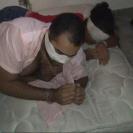
Nicolas and Coralie Moscoso found handcuffed and blindfolded in bathroom at an abandoned house. Kidnapped by faked police in black hood. Rescued by real police in black hood!
Calixte, when pressed, would not elaborate on the “personal feud” or as he said, “un règlement de compte” that caused the “removal” of the Moscoso victims who were found held hostage, handcuffed and blindfolded inside the abandoned residence Clifford Brandt took the police to.
In researching this case, a quick internet name search of the Moscoso kidnapped victims garnered this FB post from the day of the kidnapping:
“Ayiti Pap Peri
Sa grav net “Haiti-kidnapping: Hier soir, vers 8hrs sur la route de bourdon, une patrouille de la #PNH cagoule aurait kidnappée #Nicholas Moscoso et sa soeur #Coralie. Source: Chantal M. Elie, Journaliste”
Nicolas and Coralie Moscoso found handcuffed and blindfolded were kidnapped by fake police in black hoods and rescued by real police, also wearing black hoods. No wonder the victims kept their heads down and were so terrified to take off their blindfolds when their police rescuers appeared. (See Haiti police rescue video at 3:49).
Alterpresse reports that Brandt is the suspected mastermind of not only a kidnapping ring, but a powerful criminal syndicate practicing forgery, counterfeiting and money laundering.
During police searches conducted at Brandt’s place, police said they found police equipment, flashing lights (des gyrophares) and a set of license plates of vehicles. They were planning “attacks against public authorities…This is a solid team. They are true professionals, which speaks of big organized crime,” said Frantz Lerebours, spokesperson for the Haiti National Police (PNH) force.
More and more, this Clifford Brandt kidnapping case sounds like that other wealthy businessman kidnapping case, all over again. This time, perhaps the victims will be heard and it won’t be business as usual.
One thing is for sure, Robert Moscoso, the father of the Brandt kidnapped victims, would probably have given his entire fortune to get his children back. The business model of making decisions based on cost effectiveness priorities and making a profit at all cost, suddenly did not apply.
Similarly, the profit consideration of foreigners is not worth the loss of life, livelihood, liberty or health of any Haitian. But the US, through the Clintons unregulated capitalists at Caracol, and in general in their reconstruction plans for Haiti, are casually swapping Haiti domestic interests, lives, livelihood, liberty, health, its future and environmental safety for getting the largest possible foreign profit to export out of Haiti. (See, Haiti: Foreign Investment means Death and Repression: A Historical Perspective.)
Until civil society stops equating business interests as the same as governmental interests or the common good, it will be business as usual.
Where’s the Haitian, courageous enough to ride Galipòt – Janjak Desalin‘s fictional horse – and put a stop to the organized international crimes in Haiti? Perhaps it’s the ones, like the policemen, who risked their lives and careers to rescue the Moscoso victims. Chapo ba and kudos to them.
Here is a Kreyòl radio broadcast of the Galipòt story and where voiceless Haiti, not the Avatar crew, speak about their lives in Caracol Haiti. Haitians working at Caracol speak to LakouNewYork, say the 200gds (about $4:74 per day or 59cent per hour) is slave wage, “they’re taking my health, this is not ‘jobs for Haiti.”
Ezili Dantò of HLLN
Oct. 23, 2012
(Check this link again for updates.
Last updated Oct 25, 2012)
******************************
Background Information
******************************
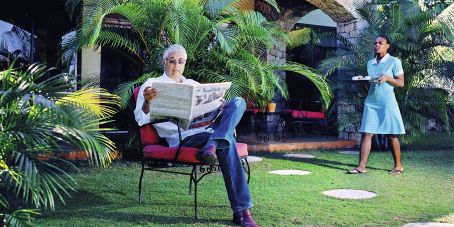 In the photo, Haiti Oligarch, Grégory Brandt, President of the Chamber of Commerce and Industry Franco-haïtienne : “Mes enfants ont étudié à l”étranger mais ont choisi de revenir à Haïti malgré la situation. Et j”en suis très fier” – “My children studied abroad, but they chose to come back to Haiti, despite the situation. It is my greatest source of pride.” Crédits : Paolo Woods / Institute (Source: Les Nantis D”Haiti;Haiti’s 1 Percent: A look at the lives of plenty in the land of the poor.) Serving maids, gardeners and butlers for blan (foreigners). Clinton/Obama and the Haiti Oligarchs “development” for Haiti is Caribbean-style tourism where Haiti’s huddled masses are exotic backdrop, convenient bodies and props for privileged Northern tourists, Paul Farmer’s false NGO benevolence and the Caracol hoax used to fleece Haiti out of its vast oil, coast lands, $20billion in gold and mineral resources.
In the photo, Haiti Oligarch, Grégory Brandt, President of the Chamber of Commerce and Industry Franco-haïtienne : “Mes enfants ont étudié à l”étranger mais ont choisi de revenir à Haïti malgré la situation. Et j”en suis très fier” – “My children studied abroad, but they chose to come back to Haiti, despite the situation. It is my greatest source of pride.” Crédits : Paolo Woods / Institute (Source: Les Nantis D”Haiti;Haiti’s 1 Percent: A look at the lives of plenty in the land of the poor.) Serving maids, gardeners and butlers for blan (foreigners). Clinton/Obama and the Haiti Oligarchs “development” for Haiti is Caribbean-style tourism where Haiti’s huddled masses are exotic backdrop, convenient bodies and props for privileged Northern tourists, Paul Farmer’s false NGO benevolence and the Caracol hoax used to fleece Haiti out of its vast oil, coast lands, $20billion in gold and mineral resources.
****
“Clinton’s oversized role in Haiti only makes sense when we remember that both the left and right see Haiti through deeply racist lenses…Clinton is the co-chair of the Interim Commission for the Reconstruction of Haiti. He is the UN Special Envoy for Haiti. And he is the co-director of the Clinton Bush Haiti Fund, a foundation involved in number of neoliberal economic initiatives in Haiti. Clinton justifies his involvement by saying he is “responding to the needs of Haitians.” But what needs? Which Haitians? And to what end?” (Bill Clinton Loves Haiti by Jemima Pierre, Black Agenda Report, Oct. 23, 2012)
****
“”¦although the oppressed often do revolt, the object of their hostility is misplaced. They vent their fury on a political puppet, someone who masks colonial power, a despised racial or ethnic group or an apostate within their own political class. The useless battles serve as an effective mask for what Gamer calls the “patron-client” networks that are responsible for the continuity of colonial oppression. The squabbles among the oppressed, the political campaigns between candidates who each are servants of colonial power, Gamer writes, absolve the actual centers of power from addressing the conditions that cause the frustrations of the people. Inequities, political disenfranchisement and injustices are never seriously addressed.”( Colonized by Corporations )
Disaster Capitalism: 0.5 % in Haiti – Haiti’s Oligarchy – own 98% of Haiti wealth through monopolies supported by Western policymakers and corporations
Haiti: Where Has All the Money Gone? – Vijaya Ramachandran and Julie Walz
The Subcontracted Haitians – Haiti overseers
Haiti servants of colonial power:
The mercenary families
Ezili Dantò: Haïti, une invasion sous couverture humanitaire
Swapping Haiti Lives: False aid, charity, orphanages, false Caracol jobs, housing or Haiti – pretext for the fake humanitarians to steal Haiti sovereignty, land & resources
Avatar unobtainium are Haiti Riches
Unobtanium in Haiti
Oil in Haiti – Economic Reasons for the UN/US occupation
Gold Rush in Haiti – Good for whom?
Video-EziliDantò:Haïti,uneinvasionsouscouverturehumanitaire
OilinHaitiandOilRefinery-anoldnotionforFortLiberteasa
transshipmentterminalforUSsupertankers
Video:Oil-StrategicdenialofoilinHaiti
AMassiveOilMineinHaiti
- To: Ezili Network Listserve
- Subject: [ezilidanto] Searching for Desalin’s horse on Caracol holocaust day-Which living Haitian can ride Galipòt? | Haitians working at Caracol speak to LakouNewYork say the 200gds is slave wage, ‘they’re taking my health, this is not jobs for Haiti’ | Obama: The African American Achilles Heel |Third piece of US election theater, the duopoly debates itself with nobody there to provide the irrefutable facts
- Date: Tue, 23 Oct 2012 15:31:38 -0700 (PDT)
Ezili Dantò’s Note: Here is a Kreyòl radio broadcast where voiceless Haiti, not the Avatar crew, speak about their lives in Caracol Haiti.
Haitians working at Caracol speak to LakouNewYork, say the 200gds is slave wage, “they’re taking my health, this is not ‘jobs for Haiti.'”
Manno, the broadcaster, points out that the minimum wage is now 300gds (as of Oct 1, 2012) not 200gds. The Caracol workers say they are only paid 200gds and not on time and it doesn’t cover their expenses whatsoever. One worker explains how she is treated like trash – like a second class citizen within the industrial park. http://lakounewyork.com/emisyon10-22-12.mp3
Also, this audio (in Kreyòl) begins with Koralen’s Galipòt. Searching for Desalin’s horse on Oct 22nd Caracol holocaust day. This Koralen performance piece asks the question “Where is the living Haitian who can ride Galipòt?” “Galipòt,” the author explains is Desalin’s horse who wanders Haiti looking for another warrior who can walk his path. http://lakounewyork.com/emisyon10-22-12.mp3
Yesterday, during the opening of the Caracol park, those Haitians who didn’t readily applaud the Martelly gov, the Clintons, Sean Penn, Richard Branson, Donna Karen Avatar crew, the opening of the Caracol mothership/Avatar Haiti were pushed out of the way, some even immediately arrested. One person who talked on this Oct 22nd broadcast about the repression was immediately arrested by the special police from FortLiberte.
Listen to:
Lakou New York Broadcast reporting on Oct 22, 2012
Another brutal October day for Haiti is celebrated by the “star-studded” Avatar crew – Sean Penn, Ben Stiller, Donna Karan, Richard Branson & the beyond-the-pale Clintons share a romantic moment. (TheAvatarMoviefroma Haitianperspective)
But this was the general mainstream media’s reporting Avatar Caracol mothership piloted by Clintons opened #Haiti again w/ sharp media propaganda http://bit.ly/Uyck9G tools= “jobs, housing for Haiti.”
Ezili Dantò of HLLN
Oct 23, 2012
*******************************************
Forwarded by Ezili’s Haitian Lawyers Leadership Network
*******************************************
Monday, Oct 22, 2012 marking day of brutal Haiti sorrow is celebrated by the “star-studded” Avatar crew (Sean Penn, Ben Stiller, Donna Karan, Richard Branson, led also by the beyond-the-pale Clinton capitalist vampires, giving cover for the corporate stealing of Haiti’s unobatainium -$20+billion, vast oil reserves in Northern Haiti, its coast lands and dismissing its cultural heritage: Bill and Hillary Share Romantic Moment In Haiti – (See, Haiti: Foreign Investment means Death and Repression: A Historical Perspective.)
CriminallyaccusedSae-A Helps Continue the Euro/US “New Day” for Haiti
TheAvatarMoviefroma Haitianperspective
***********************
Brandt Cousin: Right now only rumors
Source: Defend Haiti, Oct. 24, 2012

PORT-AU-PRINCE, Haiti (defend.ht) – “As of today everything is rumors,” Cedric Brandt said about the arrest of his cousin, a businessman named Clifford. Brandt said the family is praying for his cousin and is happy that the Moscoso’s were returned to their parents.
“Some say other people are involved but nothing is confirmed…” Brandt messaged DH noting that it is an investigation that is constantly evolving.
Cedric says Clifford is a cousin, his father is Gregory Brandt who was featured on Foreign Policy magazine Haiti’s 1 Percent. But the
Cedric Brandt
***
young Brandt said the relationship between the family and his cousin Clifford had become estranged.
Clifford has been cooperating with police even taking them to where the two kidnapped victims were being held.
“As a cousin today we are happy that the Moscoso parents were able to get their kids and we are praying now mostly for Clifford’s parents who are suffering a lot,” he concluded in a statement.
Police say the kidnappers requested $2.6 million for the release of Coralie, 23, and Nicolas, 24, Moscoso who were picked up on Bourdon Road. The police call it “enlevman” and defense lawyer Calixte Delatour said there exists a difference between “ènlevman” and kidnapping.
*****************************
Haïti-insécurité: Clifford Brandt arr êté pour implication dans un réseau de kidnappeur
Source: hpnhaiti.com
Oct 23, 2012
Clifford Brandt, fils d”uneriche famille haïtienne a été arr êté par la police nationale dans une affaire de kidnapping où il aurait participé à l”enlèvement de deux enfants en octobre dernier, a appris Haiti Press Network de source policière.
“Oui Clifford Brandt a été ar ête. Il est actuellement en detention à la Direction de la police judiciaire (DCPJ)”, a indiqué mardi à HPN le porte-parole de la police nationale annonçant l”ouverture d”une enqu ête.
Selon Frantz Lerebours joint au téléphone, Clifford Brandt n”a pas nié son implication dans l”enlèvement le 16 octobre dernier de Coralie et de Nicolas Moscoso, deux enfants d”un entrepreneur haïtien.
Le kidnapping a été effectué sur la route de Bourdon, a informé la police.
“Les mobiles de l”enlèvement des enfants Moscoso ne sont pas connus, mais il pourrait être fait dans le but de gagner de l”argent . De toute facon une nenqu ête criminelle est en cours”, a déclaré Frantz Lerebours peu bavard sur cette affaire.
*****
Haïti/ Mafia : L”homme d”affaires Clifford Brandt appréhendé pour kidnapping par la PNH.
Oct 23, 2012 08h11 | Par BZ , Source: Bonzouti.com La police nationale d”Haïti a appréhendé dans l”après-midi de ce lundi 22 Octobre Clifford Brandt, fils de l”homme d”affaires Fritz Brandt, accusé de kidnapping.
Cette arrestation a eu lieu à Delmas 02 lors d”une opération musclée entamée depuis dimanche dernier.
Deux enfants des Moscoso kidnappés depuis plusieurs jours ont été retrouvés et libérés par la PNH. Celle-ci affirme avoir retrouvé dans le fief des kidnappeurs une liste de personnalités à kidnapper au cours de la période des fins d”année.
Clifford Brandt aurait reconnu son implication dans plusieurs kidnappings dont celui des enfants Moscoso.
Sur les réseaux sociaux on félicite la PNH pour l”arrestation de ce gros bonnet de la mafia haïtienne, on craint également l”évasion de prison de Clifford Brandt.
Notons que le mafioso Clifford Brandt est le directeur de la Maison Mazda à Delmas. Il exigeait 02.5 millions de dollars américains pour la libération des deux enfants Moscoso.
*****
Haiti police investigate prominent businessman for alleged role in kidnapping ring
By Associated Press, Updated: Wednesday, October24, 5:54PM Source: Washington Post
PORT-AU-PRINCE, Haiti — Police detectives are investigating the son of one of Haiti’s prominent families for his alleged role at the center of a kidnapping ring, authorities said Wednesday.
Police spokesman Frantz Lerebours said businessman Clifford Brandt was locked up Monday on suspicion of involvement in kidnapping two children of another family in the capital, Port-au-Prince.
Lerebours said Brandt took investigators to the place where the children were being held and police freed them.
Detectives also jailed two alleged accomplices suspected of driving a Toyota Land Cruiser to carry out the kidnapping. The two suspects were caught as they tried to cross the border into the neighboring Dominican Republic, Lerebours said.
Brandt runs a car dealership and is the son Fritz Brandt, head of a prominent Haitian family that has extensive holdings in export-import businesses.
Secretary of State for Public Security Reginald Delva told Scoop FM radio that the kidnapper demanded more than $2 million for the release of the two abducted children.
Brandt’s lawyer, Delatour Calixte, told Scoop that Brandt did lead police to where the children were being held, but denied his client participated in a kidnapping. He suggested Brandt may have organized their “removal” in a family dispute.
“Removing a person is not the same thing as kidnapping,” Calixte said. “There’s a difference between kidnapping and a personal problem…. I have to say one thing: Mr. Brandt was never involved in kidnapping.”
************************
Haiti probes businessman for alleged kidnapping
October 24, 2012 21:41 GMT
PORT-AU-PRINCE, Haiti (AP) — A Haitian police spokesman says detectives are investigating the son of one of Haiti’s prominent families for his alleged role at the center of a kidnapping ring.
Haitian police spokesman Frantz Lerebours says Clifford Brandt was locked up Monday on suspicion of involvement in the recent kidnapping of the children of another family in Haiti’s capital, Port-au-Prince.
Lerebours says Brandt took investigators to the spot where the two children were being held and police freed them.
Detectives also jailed two alleged accomplices suspected of driving a Toyota Landcruiser to carry out the kidnapping. They were caught as they tried to cross the border into the Dominican Republic.
Brandt’s lawyer says his client is innocent.
Lerebours made the disclosure to The Associated Press on Wednesday.
*****
The Clintons in Haiti: Can an Industrial Park Save the Country?

Larry Downing / AFP / Getty Images
From left: U.S. Secretary of State Hillary Clinton is joined by U.S. Senator Pat Leahy, and her husband, former U.S. president Bill Clinton while receiving a briefing about a new power plant during their visit to Caracol, Haiti, on Oct. 22, 2012.
In Haiti, the western hemisphere’s most underdeveloped nation, the north is one of the most neglected regions, snubbed for centuries by a political and economic elite entrenched mainly in the country’s southern capital, Port-au-Prince. But Haiti’s massive 2010 earthquake, which wrecked Port-au-Prince and killed more than 200,000 people, made domestic leaders and international donors alike realize that Haiti has to start developing away from its overpopulated, quake-vulnerable south and tap the potential of northern cities like Cap Haitien.
That strategy, part of a “build Haiti back better” vision, took a crowning if controversial step this week. On Monday, Haitian President Michel Martelly, joined by U.S. Secretary of State Hillary Clinton and a host of political and business luminaries that included her husband (and U.N. special envoy to Haiti) former U.S. President Bill Clinton, inaugurated the Caracol Industrial Park, a $300 million, 600-acre (246-hectare) facility near the country’s north coast, east of the seaport city of Cap Haitien. The Caracol inauguration was the first joint trip to Haiti by the Clintons since they visited the Caribbean nation shortly after they wed in the 1970s. Now they’re hoping Caracol will be the start of a more productive marriage between Haiti and the international donors and investors it so desperately needs just to build back, let alone build back better.
A mock Haitian village was erected for the occasion, as celebrities like British tycoon Richard Branson looked on beneath banners proclaiming “A New Day in Haiti.” Martelly, whom Hillary Clinton gushingly praised as the “chief dreamer and believer,” declared the modern plant and the 130,000 jobs it’s expected to create as proof that despite the usual “sad images of Haiti,” the country “is open for business, and that’s not just a slogan.”
Like Martelly, the U.S., which is leading the international effort to rebuild Haiti, has been eager to present an accomplishment of Caracol’s magnitude amidst what critics have called a slow reconstruction effort. Reassuring evidence of progress is crucial to getting the billions of dollars that international donors have pledged to Haiti”but half of which has yet to be delivered, largely because of the uncertainties on the ground”into the pipeline. “The people of this country have made real progress in a short time,” Hillary Clinton told investors after touring the park, “and we’ve reached a critical moment.”
(MORE: Haiti’s Quake, One Year Later: It’s the Rubble, Stupid!)
The Caracol park had actually been in the works since 2008. But the earthquake gave the project”a joint effort by the Haitian government, the U.S. State Department and the International Development Bank, which committed an initial $55 million for construction”a more urgent impetus. What’s more, it has become a hub for broader development in the north. Cap Haitien’s airport is undergoing an expansion, funded by Venezuela and Cuba, which allowed it to receive its first large international carrier this month. A gleaming, $30 million campus of Roi Henri Christophe University, built by the Dominican Republic, is set to enroll its first students in two weeks. A new port is planned for nearby Fort-Liberte, though it is currently on hold due to environmental and political tensions.
Caracol’s founding private investor, South Korean textile company Sae-A Trading Co. Ltd., which planted $78 million into the park, has already begun production”and the 1,000 Haitians it has so far employed sent their first order, a batch of 76,000 T-shirts for Walmart, last week. “The easiest job to create is [in] textile garment manufacturing,” says George Sassine, general director of SONAPI, Haiti’s national governing body for industrial parks and one of Caracol’s earliest backers. “It’s a very light investment, but it influences a lot of people.” Caracol “is not the panacea for Haiti’s economy,” he adds. But “we want to show this as a showcase of what can be done.” Says Josepha Gauthier, Haiti’s Works and Social Affairs Minister, agrees: “I always believe that Haiti’s development will come through its countryside” and provinces, not Port-au-Prince.
But development rarely comes without disputes, and for many Haitians and foreigners alike, Caracol is also a reminder of the pitfalls to building Haiti back better. For starters, there is concern that while Sae-A has promised to create 20,000 jobs, it has had labor troubles in other developing countries and may not be the world’s most employee-friendly enterprise. Late Monday afternoon, after rain began to fall at Caracol and Hillary Clinton had stepped into her car to leave, many workers filed out of the Sae-A factory after a shift and complained that they make only Haiti’s daily minimum wage of 200 gourdes, just under $5. Sae-A says pay will rise after six months of training.
There are also tensions between industrial developments like Caracol and the just as urgent, if not more critical, need to foster agriculture in Haiti, which imports more than half its food. Gabriel Charles, 45, had employed as many as 30 people at a time to farm corn, sweet potatoes and beans on the fertile land around the town of Caracol. “I had a hectare [2.5 acres] and that hectare took care of my family,” says Charles, who had to give it up for the park but says the compensation he received for it was inadequate. “I agree with the industrial park,” he says. “But you [also] have to take care of the peasants.” Other displaced farmers, still awaiting alternate plots of land that were promised them, are protesting what they call the park’s adverse economic effects, including the recent doubling of the price of beans, due in part to reduced harvests.
Environmental issues loom large as well: experts fear increased industry could harm Haiti’s ecologically important yet fragile northern coastline, including coral reefs. So do concerns that while developing the north is a good thing in the long run, it doesn”t solve the more immediate post-quake suffering in the south”including the nagging tragedy of hundreds of thousands of homeless Haitians still living in squalid tent camps. Critics also point out that the lure of industrial jobs in the 20th century was a cause of Port-au-Prince’s overcrowding and the proliferation of its notorious slums. They warn Martelly and international donors to avoid the same phenomenon in northern urban areas like Cap Haitien, Haiti’s second largest city.
All of which has helped stoke recent anti-government protests in the north. “We say bravo to the investments,” says Garry Denis, spokesman for the Citizen’s Initiative. But he insists that “so far foreigners and people from Port-au-Prince are the ones who are benefitting.” His group also wants Martelly to address the high cost of living and overdue municipal elections. The unrest comes at a rocky time for Martelly and Prime Minister Laurent Lamothe, whose government faces corruption allegations (they deny them) and other political crises that have hampered reconstruction. Hillary Clinton hinted at Haiti’s dysfunction in her Caracol comments. “In addition to effective government,” she said, “Haiti needs a strong justice sector, free and fair elections, housing, energy, schools, health care.”
Read more:In Haiti, the western hemisphere’s most underdeveloped nation, the north is one of the most neglected regions, snubbed for centuries by a political and economic elite entrenched mainly in the country’s southern capital, Port-au-Prince. But Haiti’s massive 2010 earthquake, which wrecked Port-au-Prince and killed more than 200,000 people, made domestic leaders and international donors alike realize that Haiti has to start developing away from its overpopulated, quake-vulnerable south and tap the potential of northern cities like Cap Haitien.
That strategy, part of a “build Haiti back better” vision, took a crowning if controversial step this week. On Monday, Haitian President Michel Martelly, joined by U.S. Secretary of State Hillary Clinton and a host of political and business luminaries that included her husband (and U.N. special envoy to Haiti) former U.S. President Bill Clinton, inaugurated the Caracol Industrial Park, a $300 million, 600-acre (246-hectare) facility near the country’s north coast, east of the seaport city of Cap Haitien. The Caracol inauguration was the first joint trip to Haiti by the Clintons since they visited the Caribbean nation shortly after they wed in the 1970s. Now they’re hoping Caracol will be the start of a more productive marriage between Haiti and the international donors and investors it so desperately needs just to build back, let alone build back better.
A mock Haitian village was erected for the occasion, as celebrities like British tycoon Richard Branson looked on beneath banners proclaiming “A New Day in Haiti.” Martelly, whom Hillary Clinton gushingly praised as the “chief dreamer and believer,” declared the modern plant and the 130,000 jobs it’s expected to create as proof that despite the usual “sad images of Haiti,” the country “is open for business, and that’s not just a slogan.”
Like Martelly, the U.S., which is leading the international effort to rebuild Haiti, has been eager to present an accomplishment of Caracol’s magnitude amidst what critics have called a slow reconstruction effort. Reassuring evidence of progress is crucial to getting the billions of dollars that international donors have pledged to Haiti”but half of which has yet to be delivered, largely because of the uncertainties on the ground”into the pipeline. “The people of this country have made real progress in a short time,” Hillary Clinton told investors after touring the park, “and we’ve reached a critical moment.”
(MORE: Haiti’s Quake, One Year Later: It’s the Rubble, Stupid!)
The Caracol park had actually been in the works since 2008. But the earthquake gave the project”a joint effort by the Haitian government, the U.S. State Department and the International Development Bank, which committed an initial $55 million for construction”a more urgent impetus. What’s more, it has become a hub for broader development in the north. Cap Haitien’s airport is undergoing an expansion, funded by Venezuela and Cuba, which allowed it to receive its first large international carrier this month. A gleaming, $30 million campus of Roi Henri Christophe University, built by the Dominican Republic, is set to enroll its first students in two weeks. A new port is planned for nearby Fort-Liberte, though it is currently on hold due to environmental and political tensions.
Caracol’s founding private investor, South Korean textile company Sae-A Trading Co. Ltd., which planted $78 million into the park, has already begun production”and the 1,000 Haitians it has so far employed sent their first order, a batch of 76,000 T-shirts for Walmart, last week. “The easiest job to create is [in] textile garment manufacturing,” says George Sassine, general director of SONAPI, Haiti’s national governing body for industrial parks and one of Caracol’s earliest backers. “It’s a very light investment, but it influences a lot of people.” Caracol “is not the panacea for Haiti’s economy,” he adds. But “we want to show this as a showcase of what can be done.” Says Josepha Gauthier, Haiti’s Works and Social Affairs Minister, agrees: “I always believe that Haiti’s development will come through its countryside” and provinces, not Port-au-Prince.
But development rarely comes without disputes, and for many Haitians and foreigners alike, Caracol is also a reminder of the pitfalls to building Haiti back better. For starters, there is concern that while Sae-A has promised to create 20,000 jobs, it has had labor troubles in other developing countries and may not be the world’s most employee-friendly enterprise. Late Monday afternoon, after rain began to fall at Caracol and Hillary Clinton had stepped into her car to leave, many workers filed out of the Sae-A factory after a shift and complained that they make only Haiti’s daily minimum wage of 200 gourdes, just under $5. Sae-A says pay will rise after six months of training.
There are also tensions between industrial developments like Caracol and the just as urgent, if not more critical, need to foster agriculture in Haiti, which imports more than half its food. Gabriel Charles, 45, had employed as many as 30 people at a time to farm corn, sweet potatoes and beans on the fertile land around the town of Caracol. “I had a hectare [2.5 acres] and that hectare took care of my family,” says Charles, who had to give it up for the park but says the compensation he received for it was inadequate. “I agree with the industrial park,” he says. “But you [also] have to take care of the peasants.” Other displaced farmers, still awaiting alternate plots of land that were promised them, are protesting what they call the park’s adverse economic effects, including the recent doubling of the price of beans, due in part to reduced harvests.
Environmental issues loom large as well: experts fear increased industry could harm Haiti’s ecologically important yet fragile northern coastline, including coral reefs. So do concerns that while developing the north is a good thing in the long run, it doesn”t solve the more immediate post-quake suffering in the south”including the nagging tragedy of hundreds of thousands of homeless Haitians still living in squalid tent camps. Critics also point out that the lure of industrial jobs in the 20th century was a cause of Port-au-Prince’s overcrowding and the proliferation of its notorious slums. They warn Martelly and international donors to avoid the same phenomenon in northern urban areas like Cap Haitien, Haiti’s second largest city.
All of which has helped stoke recent anti-government protests in the north. “We say bravo to the investments,” says Garry Denis, spokesman for the Citizen’s Initiative. But he insists that “so far foreigners and people from Port-au-Prince are the ones who are benefitting.” His group also wants Martelly to address the high cost of living and overdue municipal elections. The unrest comes at a rocky time for Martelly and Prime Minister Laurent Lamothe, whose government faces corruption allegations (they deny them) and other political crises that have hampered reconstruction. Hillary Clinton hinted at Haiti’s dysfunction in her Caracol comments. “In addition to effective government,” she said, “Haiti needs a strong justice sector, free and fair elections, housing, energy, schools, health care.”
*****
Americans arrest top Cedras bodyguard
by Phil Davidson
The Independent, October 4, 1994
HE LIKED to be called the ‘Shooting Star,’ used his red sports car as target practice and led the menacing black-hooded group known as the ‘Ninjas’ who guarded Haiti’s de facto military ruler, General Raoul Cedras.
In the biggest coup so far for the US occupation force here, American troops on Sunday night detained Romeo Halloum, officially known as General Cedras’s chief of security, but widely believed to control the so- called ‘attaches’ or para- military thugs who have long ruled the streets. The shadowy Mr Halloum, aged around 38, is an American citizen and he claims to have served in Vietnam.
The Americans also detained his three brothers, and a fifth man who formed the ‘Ninjas’ in one of a series of raids aimed at netting armed opponents of the exiled President, Jean- Bertrand Aristide.
The five, thought to have been moved to US Navy vessels off-shore, are all of Syrian or Lebanese origin, part of a core of Arab families who control a large chunk of big business in Haiti, thought to include arms and drugs smuggling.
Mr Halloum was believed to have had control of Port- au-Prince airport, allowing him to smuggle in goods and break the UN embargo.
General Hugh Shelton, commander of US forces on the island, yesterday described Mr Halloum and the other detainees – thought to be Ramses Halloum, Jerry and Patrick Mourra and Alex Fonbrun – as ‘thugs’. He said that one of them had been involved in an incident last week, in which a grenade was thrown at Aristide supporters, killing seven people and wounding 60.
Commenting on the fact that Mr Halloum, and perhaps one or two of the others, is an American citizen, General Shelton said: ‘They will be handed over to the legitimate government of Haiti (that of President Aristide when he returns) but our justice will get the first shot at them.’
Mr Halloum is the son of a well-known Haitian-American of Lebanese origin, who was a captain in the US army. He was raised in Miami and surfaced publicly about a year ago as General Cedras’s chief of security and bodyguard.
As the US stepped up talk of an invasion a few months ago, the so-called Ninjas began appearing with General Cedras in public, dressed in black uniforms and black hoods. Reporters who knew him recognised Mr Halloum’s hazel-green eyes. He was fond of threatening journalists.
When a United Nations convoy was stopped by 30 attaches at a roadblock two months ago and robbed it of its walkie talkies and other equipment, UN staffers recognised Mr Halloum as the leader.
******
How Haiti’s Future Depends on American Markets
CARACOL, HAITI–Along the highway that parallels Haiti’s north coast, not far from the bay where Christopher Columbus’s Santa Maria is believed to have shipwrecked on Christmas Day in 1492, giant billboards with smiling faces dot the landscape of alternating crop fields and scrub acacia. The billboards carry the country’s new mantra: “Haiti is open for business.”
The cliché gains at least a little credence in this case from a $300 million industrial park, backed by the U.S. government and other donors. The single biggest investment in Haiti since the devastating earthquake of January 2010, the park symbolizes the debate about foreign-led economic development in very poor nations. Its backers say it will bring tens of thousands of jobs to a country in desperate need of them, while critics see it as merely another way for foreign firms to exploit cheap labor.
The reality is that the park could be both a quick way to create jobs and a means to boost the nation toward industrialization–and many locals, at least, say it gives them hope. But its success depends on manufacturers there making the transition fairly fast from cheap clothes to higher-value products–or else on the U.S. continuing to give preferential trade terms to Haitian goods.
The industrial park sits just south of the small coastal town of Caracol and employs 1,600 people today, in an area where there are three main alternatives: farming, fishing, and leaving.
The Haitian government estimates unemployment at 40.6%, but the official figure pales next to the reality that around three-quarters of Haitians struggle to scratch out a living each day in the informal sector. “We had learned that supporting long-term prosperity in Haiti meant more than providing aid,” U.S. Secretary of State Hillary Clinton said at the October inauguration of the park, where visitors included her husband, ex-president Bill Clinton, and celebrity actors Ben Stiller and Sean Penn. “It required investments in infrastructure and the economy that would help the Haitian people achieve their own dreams.”
Haiti is not the easiest place to run a business. It lacks reliable electricity, good roads and ports, and solid institutions. But it managed to attract Korean textile manufacturer Sae-A Trading Co., among the largest in the world, as the anchor tenant of Caracol Industrial Park.
The U.S. government put up $124 million for an on-site power plant and other infrastructure. The Inter-American Development Bank (IDB) promised $100 million to build the park. The government of Haiti gave Sae-A a 15-year tax holiday. Sae-A itself pledged $78 million to cover equipment and operations, with a reportedinitial investment of $39 million.
Sae-A public affairs officer Karen Seo says the “decision to invest in Haiti became clear” with the international aid package. But there was one other sweetener, which officials say was the linchpin of the whole deal: U.S. legislation that, with a few conditions, gives apparel imports from Haiti duty-free status.
Backers claim that Caracol Park could eventually create 60,000 jobs, albeit mostly low-paying work assembling garments. The minimum daily wage for textile workers in Haiti is 200 Haitian gourdes, about $5. (In 2011, the UN reported that 75% of Haitians live on less than $2 per day.)
Experts caution that in the global textile industry, margins in low-value production can hardly pay Haiti’s $5 per day minimum wage.
The project has been controversial. Building it meant displacing about 350 familiesfrom the fertile stretch of state-owned land that an American consulting firm identified as a suitable spot. The area contains an important watershed, which makes it prime farming land, and some worry that the park’s water usage and disposal could upset the local ecology. Most residents either fish or grow crops such as black beans or plantains. Mangroves grow in the bay, home to one of Haiti’s few intact coral reefs. Both guard against shoreline erosion and provide wildlife habitat; a 2009 study estimated the direct economic value of the mangroves and reef at $110 million. Local officials say they weren’t consulted about the park’s potential location.
Last month’s collapse of a garment factory in Bangladesh has put the conditions of workers who make clothes for the rich world in the spotlight. In Haiti, U.S. trade preferences require the creation of a program called Better Work, run by the International Labor Organization, to bring labor laws up to international standards and inspect factories. Many factories don’t yet meet the standards (pdf, p. 15), particularly on health and safety and minimum wages, but the Caracol facility is too new to have been included in the latest Better Work report.
Others worry about the social consequences. Amy Wilentz, one of the best known American writers on Haiti, called the park “a new kind of plantation” and compared low-wage factory work to slavery. Others have decried the idea of using low-paying factory jobs as a step in the country’s development. Some say that Haiti has already tried this strategy, and failed, or that the investment would be better spent in agriculture.
It’s certainly true that Haiti’s apparel sector has boomed before. A 2010 Congressional Research Service report estimates that it employed up to 100,000 people between the 1960s and the end of the Duvalier dictatorship in 1986. A military coup in 1991 led to a trade embargo that hamstrung the industry, at the same time that competition was growing from regional neighbors like Honduras and emerging markets in Asia.
Hans Garoute, a Haitian social entrepreneur, remembers that period. At the time, he says, U.S. manufacturers in Haiti that had initially produced only low-value goods like t-shirts and underwear were starting to make products that command higher prices and wages. But in the political chaos of the late ’80s, he watched many of those companies move production to Asia. “Today,” he says, “we’re back to t-shirt.”
Apparel manufacturers have slowly rebuilt since the end of the trade embargo, with the help of a U.S. law passed in 2006 that allowed Haitian apparel to enter America duty-free. The law, known as HOPE (the Haitian Hemispheric Opportunity through Partnership Encouragement Act) was amended and expanded in 2008, and after the 2010 the earthquake, expanded once again through HELP (the Haiti Economic Lift Program). Employment in Haiti’s textile sector has rebounded to about 30,000.
In 2009, knit and woven apparel accounted for 92% of Haiti’s exports to the United States. Haiti needs growth like that to counterbalance its large trade deficit–$3 billion in 2011 according to the World Bank, or 41% of GDP. Haiti exports crops such as mangoes, cacao, and coffee, but agricultural products comprise only about 6% of all exports. The country imports 80% of the rice it consumes, mostly from the United States. Decades of deforestation and soil erosion, the lack of a modern farming sector, and government subsidies doled out to American farmers make it difficult for Haitian farmers to compete globally.
“Working in a factory is not a gift,” says Garoute, “but believe me, sitting in Trou-du-Nord and do nothing, and you are 24 years old, that is worse.” In 1992, Garoute founded INDEPCO, a non-profit network of tailors across Haiti who sew school uniforms and other garments for the domestic market. It also does training sessions, like one it held last year in the northern town of Trou-du-Nord for a group destined to work at the Caracol park.
But in the global textile industry, margins in low-value production can hardly pay Haiti’s $5 per day minimum wage, Garoute says. “They have China making t-shirt,” he says. “They have India making t-shirt. You have Pakistan making t-shirt. And don’t forget, those countries make the raw material as well.” He says that Haiti’s textile industry will only grow into higher-value-added production with proper investment in the workforce.
At the industrial park, female workers wearing chartreuse aprons and headscarves stream out of the blue factory buildings on their lunch break. Frandline Joseph sits outside. She sews for Sae-A and says she doesn’t like the work: “I don’t have time to sit.”
But she also says that she had no job before her current one, and life has improved since finding employment. “Now I work for 200 gourdes,” she says, and can pay her daughter’s school fees in a country with a virtually non-existent public education system. “Before the park, I worked for nothing.”
Her story is similar to other published accounts, and that of Rosedaline Jean, a 22-year-old who’s worked for Sae-A for five months. “Before, I lived only by the grace of God,” says Jean. “Although I don’t have a husband or children, my life wasn’t easy because I wasn’t working. When I got here, a lot changed in my life.
“This isn’t the ideal job,” she continues, “but it’s better than nothing. I don’t intend to make a career in this job. I plan to start a business, and I’m already saving for it. But it’s difficult, because my salary is practically nothing.”
Haiti’s northern coast faces the United States, and so it is from this part of the country that people leave on makeshift boats, bound, they hope, for a better life. “The park can be good if it can give you a job,” Edouard Riche, a maintenance worker there, said, as we watched a couple of fishing boats skimming the surface of the water. “If you have work in Haiti,” he said, “you don’t need to take a boat abroad to look for work.”
Sae-A shipped 76,000 t-shirts to Wal-Mart in October of last year, the first products from the factory. It now employs 1,400 people and says that number will double by the end of 2013. It hopes to create 20,000 jobs in total over the coming years. The park’s only other tenant is Peintures Caraïbes, a Haitian company that makes paint for Sherwin-Williams and employs about 200 people. Last month, U.S. garment company Safi Apparel signed a contract to become the park’s third occupant.
Georges Sassine, a Haitian textile manufacturer and and the former head of SONAPI, the Haitian industrial parks agency, says the industrial park’s cheap-manufacturing strategy is “just a time-buying procedure.” But he is adamant that the Caracol development is viable only thanks to the duty-free access to America. The extension granted by U.S. lawmakers after the earthquake continues that tariff exemption until 2020. Whether Haiti can develop a higher-value-added textile sector by then–or whether U.S. lawmakers extend the legislation again–remains to be seen.
Add a comment:
Powered by Facebook Comments

